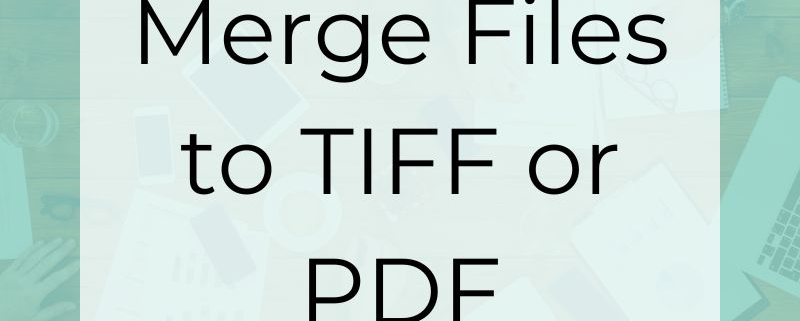Merge Files to TIFF or PDF
Learning how to merge files to TIFF or PDF is simple and the benefits are many. In todays world of digital files from multiple applications, emails and cloud-based document sharing, managing our digital clutter has a direct impact on our workflow and productivity.

Merging multiple documents to a single TIFF or PDF allows for better organization and easier file sharing. It also means less files to store and manage.
The PEERNET family of image printers has always been able to combine multiple files into a single TIFF file. Now, starting with the release of 12.0.015, our users can now also combine multiple files into a single PDF file.
When Would I Need to Merge Files?
If you’re reading this, chances are it’s because you already need to merge files and want to learn how. What you might not know is the many ways combining files can help in your daily tasks.
Both TIFF images and Adobe PDF files have a multi-paged format that stores multiple pages in a single file. Which file format you use depends on your requirements and we discuss that later below.
Merge from Different Applications
One of the most common reasons to merge files to TIFF or PDF is to combine information from different applications into a single file. Perhaps you have medical records from different applications and need to store them as a single file for archiving. Or you need to combine different reports and spreadsheets to share with a client or co-worker for review.
Merge Existing TIFF or PDF Together
Merging files isn’t always about combining different files types into a TIFF or PDF file. You can also merge existing TIFF and PDF files into a single document. You can mix existing TIFF or PDF files with other files types to create your final TIFF or PDF document. Many times you will need to combine a mix of different files, including TIFF images and PDF documents.
One advantage of our image printers is their ability to take documents with different page sizes, orientation and color and create a single document with the same page size, orientation and color for each page. When dealing with files and documents from various sources, this allows for combining all pages into a single, uniform and consistent file for easy viewing.
Advantages of Merging to TIFF or PDF
Less is More
Instead of scattered files in multiple folders and locations, combining all files for an in-house project, client review, insurance case or other task will increase productivity. No more searching for the correct file or opening up multiple files in different applications to get the information you are looking for. That also assumes you have the application needed to open up all of the files, which may not be the case. Merging all files into a single TIFF or PDF document means you only need one application to open the file, and all of the information is in one place.
This can also help to free up storage space. Both formats have compression options that can reduce the size of the final saved document. Less files, less space and easier access is a winning combination.
Viewing Across Devices
The days of needing a desktop computer for all our daily tasks are no more. Tablets, phones and other devices are now more the norm than the exception. That means our documents need to be easily viewable on different devices running different operating systems – Android, Chrome, iOS to name a few.
The Word document and Excel spreadsheet you created so carefully for your project may not be viewable on an Android phone or tablet. They may not look correct when viewed on an Apple iPad even if your target audience can open the file. PDF documents or TIFF images, however, usually have standard viewers available on all devices. Merging your documents into a TIFF or PDF allows your document to be opened and viewed as intended, no matter which type of device is used.
Online File Sharing and Email
Online file sharing services OneDrive, Google Workspace and Dropbox have made huge jumps in popularity and usage over the last few years. They are now widely in use by companies, schools and home users alike. Rather than uploading multiple files, it is faster, and easier, to upload a single file. The same is true about group-chat software such as Microsoft Teams or Slack. Many of these services have mobile apps for tablets and phones as well as traditional desktop applications. Using a merged TIFF or PDF means the documents are easily viewable from inside the file sharing or group-chat app on any device.
In the same vein, emailing documents to co-workers and clients is far simpler when there is only one file to attach. Using a merged PDF or TIFF also provides assurance to the person receiving the email will be able to open and read the file.
Printing
The switch to online file sharing and the growing popularity of a paperless office has reduced our need to physically print files as part of our day to day tasks. However, there are times when a printed copy is needed. It is far easier to print a single file than to open and print multiple files individually from separate applications.
Should I Merge Files to TIFF or PDF?
TIFF images were an industry standard for document archiving in the legal, banking and insurance industries for a long time. While they are slowly being replaced with PDF files, many places still use TIFF images today. Faxing software and online fax services also relied on specially formatted TIFF images. Today they often support both TIFF and PDF.
Each page in a TIFF image is picture of the page. This means that text and images cannot be easily copied nor can they be changed. This provides a level of security for the file contents. TIFF images provide lossless compression, producing high-quality, readable files.
Most computers have built-in applications for viewing TIFF images, but not all image viewers can properly view multipage TIFF images.
PDF files are becoming the new industry standard for sharing files. They are slowly replacing the use of TIFF images in many archiving and content management systems. With built-in PDF viewers or Adobe Reader available on most computers, PDF files are viewable by pretty much everyone.
Additionally, if desired, you can create PDF files where you can search and copy text inside the file. TIFF images are not searchable unless they are part of a content management system with Optical Character Recognition applied. Security options inside PDF allow setting passwords for opening the file. Other individual permissions on copying content, printing, and changing the document are also available.
Conclusion
Now that you know the benefits of merging files into a TIFF or PDF file and how they can improve your workflow and productivity, have a look at our image printers. See how they can help you make merging files from many different sources into a single file a simple task. Download a trial of TIFF, PDF or Raster today.



